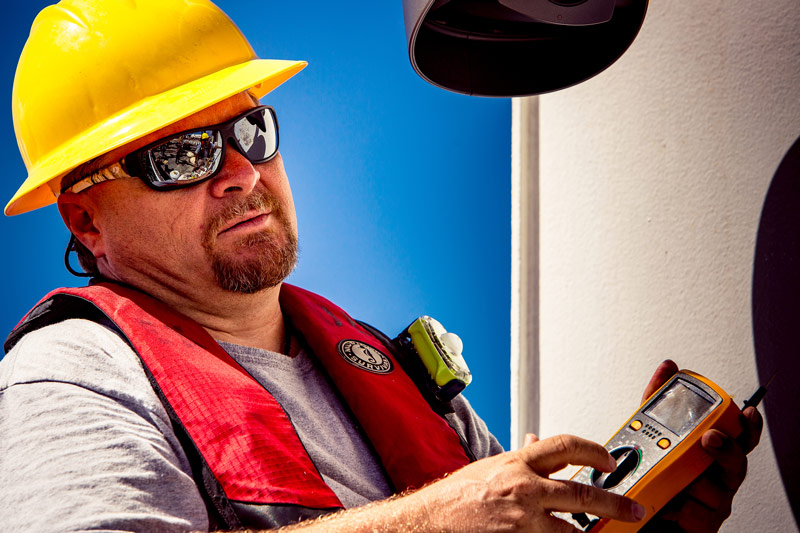
By Emily Narrow, Global Foundation for Ocean Exploration
August 10, 2016

Video engineer Roland Brian works to troubleshoot some of the ship’s video equipment. Image courtesy of the NOAA Office of Ocean Exploration and Research, Deepwater Wonders of Wake. Download larger version (jpg, 3.5 MB).
This past May, I got a call at 8AM on a Monday morning. I usually don’t receive calls that early in the day, and so I almost didn’t pick up. But, boy, am I glad that I did. It was David Lovalvo, the founder and president of the Global Foundation for Ocean Exploration. He was offering me a job onboard NOAA Ship Okeanos Explorer. The ship and its crew were going to be exploring the Wake Atoll Unit of the Pacific Remote Islands Marine National Monument, now known as Pacific Islands Heritage Marine National Monument, using deepwater remotely operated vehicles (ROVs).
Would I be interested in joining the video team to document the four-week expedition? Yes, yes, I would.
I am a video producer and editor who specializes in science and natural history content. I had done some work for David Lovalvo before; I had been one of a small team of filmmakers who documented the Ocean Exploration 2020 National Forum in Long Beach, California, in 2013. There I had filmed round table discussions and presentations by some of the world’s leading scientists and ocean explorers. However, the forum had taken place on dry land. This new opportunity from Mr. Lovalvo and the Global Foundation for Ocean Exploration would require me to live and work onboard a ship at sea in the Pacific Ocean. It would be an entirely new experience for me.
In late July, I flew to Guam where the Okeanos Explorer was in port, and my crewmates led me aboard the ship. I spent the next three days getting acquainted with the ship and her crew, and we got underway on July 27.
The expedition coordinator for the trip, Brian Kennedy, asked me to write a log entry about my experiences on the ship. On each cruise, he usually asks the new person to write about his or her impression of life aboard the Okeanos Explorer. I came up with a couple ideas for topics. I could write about the impressive technological achievement of the ROV Deep Discoverer. Or I could write about adjusting to life at sea (and the inevitable bout of sea sickness I experienced). But I realized that what I really wanted to write about were the people onboard the Okeanos Explorer.
I can confidently say two things about every single crewmember onboard this ship: they are incredibly knowledgeable in their field of expertise, and they are passionate about the work that they do. And it’s the combination of these two things that makes this whole operation work.
Never is this more apparent than when things go wrong. And lately, a couple of things have gone wrong. The ship’s primary communications system went down. Then the multibeam sonar (which allows us to map the underwater topography of the dive sites) stopped working. A few days later, the room housing all the servers lost power. None of these situations was ever grave enough to cause us to cancel the expedition and head back to port (the integrity of the ship and the safety of the crew were never in doubt). But these obstacles made the job of exploring the ocean harder and harder.
So when things went wrong, it was the knowledgeable, passionate crew of the Okeanos Explorer that made them right. When the primary communications system went down, the video engineer strapped himself into a safety harness, climbed up the ship’s nearly 20-foot communications tower, and climbed into the VSAT dome to find the problem. He did this for three days straight until he was able to identify and fix the problem.
When the multibeam sonar stopped working, the mapping team and the electronics technician took the system’s onboard computer apart. They found which of the sonar computer’s 50 circuit boards was malfunctioning and replaced it with a spare, good as new.
And when the server room lost power, the electronics technician and the ROV engineers worked to rebalance the loads that fed the breaker panel.
In each case, it was the crew members’ technological acumen and dedication that solved the problem.
Now, I am not a mechanically savvy person. When the “Check Engine” light comes on in my car, I don’t check the engine. I just keep driving around and hope that the car doesn’t die anytime soon. And when the car does eventually die, I don’t bother even looking at it. I just take it to a mechanic.
But the crew of the Okeanos Explorer is a different breed. When the “Check Engine” light comes on in their cars, they take apart the engine, replace the faulty part, and flawlessly rebuild the engine—all while wearing a smile. They don’t get bored or frustrated when confronted with an unsolved problem. When things break, they don’t shrug their shoulders and walk away. They painstakingly dissect the machine in front of them, root out the malfunction, and then rebuild. Which, frankly, is exactly the type of person you want onboard when you’re exploring the ocean.